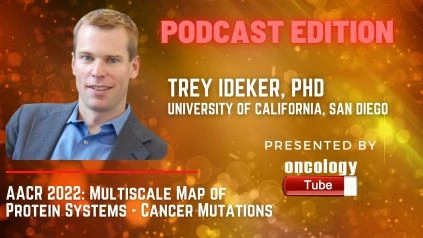Trey Ideker, Ph.D., UCSD Professor of Medicine, Bioengineering and Computer Science, and former Chief of Genetics. He directs or co-directs the National Resource for Network Biology, and the Cancer Cell Map and Psychiatric Cell Map Initiatives at the University of California, San Diego. In this video, he speaks about the AACR 2022 presentation based on the study – Interpretation of cancer mutations using a multiscale map of protein systems.
Â
Intro:
Â
Tumor genome sequencing has revealed that other than a few typically altered genes, the majority of mutations affecting cancer genomes are uncommon. A powerful technique for interpreting these unusual events has been to group mutations based on their effects on typically dysregulated biological systems. Understanding the cancer genome in this manner necessitates overcoming two obstacles.
Â
How do we map cancer cell systems in their entirety? (ii) How do we know which systems are subject to mutational selection?
Â
Reasoning:
We employed proteome mass spectrometry and data integration to create a structured map of protein assemblies observed in human cancer cells to answer these concerns. We then created a statistical model of mutation to identify which assemblies are under intense mutational selection and which cancer types are affected by it. The idea was to use higher-order entities to interpret the many uncommon gene changes that alter tumor genomes.
Â
Findings:
We compiled a comprehensive database of cancer protein interactions by merging data from breast cancer (Kim et al., this issue) and head-and-neck cancer (Swaney et al., this issue) screenings with multi-omic evidence from 127 prior investigations. Lines of evidence were quantitatively integrated to produce a continuous measure of connection for each protein pair (integrated association stringency, or IAS). This protein association network revealed a distinct multiscale and modular structure, demonstrating 2338 robust assemblages of interacting proteins (hereinafter “protein systems”) across multiple stringencies. As stringency was eased, systems were arranged hierarchically, with small high-stringency systems (e.g., particular complexes) integrating in bigger ones (e.g., processes and organelles). Following that, we created HiSig, a statistical model that identifies a small group of systems that best describes the gene mutation frequency reported in cancers. The HiSig investigation of 13 tumor types resulted in a map of 395 altered protein systems that we name NeST (Nested Systems in Tumors, http://ccmi.org/nest/). NeST was composed of multiple tiny complexes, the majority of which were mutated within specific tumor types and were grouped within bigger systems relevant to the majority of cancers.
Although NeST replicated cancer hallmarks, the majority of systems had not previously been characterized or were not related with cancer mutation. Nonetheless, many were found to be recurrently mutated in independent cohorts, lending credence to their importance. A PIK3CA-actomyosin complex that hints to a new way of phosphatidylinositol 3-kinase regulation, as well as recurring mutations in collagen complexes that we discovered to damage the extracellular matrix, hence boosting proliferation, were notable systems. Finally, we discovered NeST systems that can be used as biomarkers for cancer outcomes, resulting in 548 genes that could be included in clinical sequencing panels.
Â
Implication:
Hanahan and Weinberg predicted in their classic description of the “Hallmarks of Cancer” that the “complexities of cancer… will become intelligible in terms of a small number of fundamental principles.” At around the same time, Alberts presented his seminal view of the cell as a collection of “protein assemblages [interacting] in a complex network.” This work reflects a synthesis of both views by unifying different tumor mutations into underlying principles recorded by a multiscale map of protein assemblies. The solutions outlined here may be applicable to other diseases caused by uncommon genetic abnormalities.

